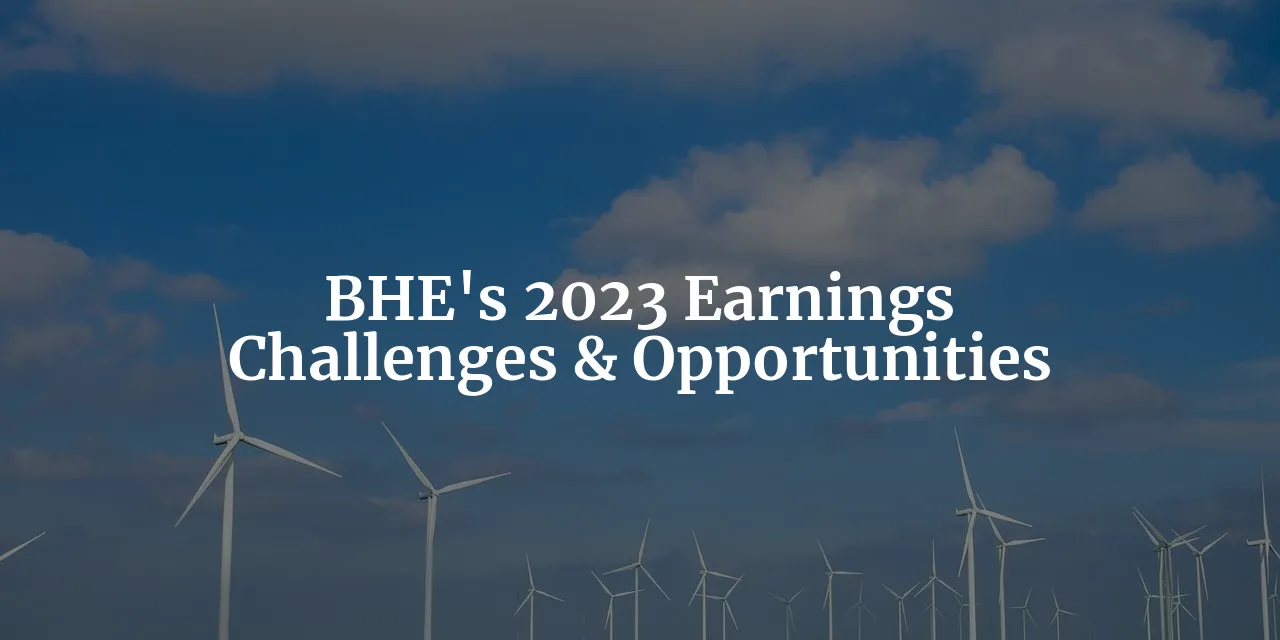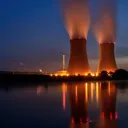Tags: BHE / Earnings
This fanpage is not officially affiliated with Berkshire Hathaway: Disclaimer
Calling all Berkshire Hathaway shareholders! Dive into the intricate world of Berkshire Hathaway Energy's 2023 earnings report. Explore the challenges, opportunities, and strategic maneuvers of this energy behemoth as it navigates regulatory hurdles, climate change impacts, and innovative investments. A must-read for investors seeking insight into the dynamic energy sector landscape.

Introduction
Berkshire Hathaway Energy (BHE), a cornerstone in the vast Berkshire Hathaway portfolio, has long stood as a testament to Warren Buffett's strategic investment philosophy. With its inception rooted in the acquisition of MidAmerican Energy Holdings Company in 1999, BHE has evolved into a behemoth within the global energy sector, navigating through the complexities of regulatory landscapes and the unpredictable wrath of climate change. The anticipation surrounding BHE's 2023 earnings report was palpable, given the tumultuous year marked by regulatory challenges and heightened climate change impacts. Warren Buffett, known for his long-term investment outlook and emphasis on acquiring companies with a strong moat, has always viewed BHE as a critical component of Berkshire Hathaway's diversified strategy. This raises a pivotal question for Berkshire Hathaway shareholders: In the face of the myriad challenges encountered in 2023, should there be a cause for concern regarding BHE's earnings?
This article aims to dissect the operations of BHE, scrutinizing the regulatory hurdles it faced in 2023 and exploring the broader implications for Berkshire Hathaway shareholders ↗ ↗. By delving into the intricate details of BHE's operational segments and their performance over the past year, readers will gain a comprehensive understanding of the company's current standing and future prospects. The journey through BHE's 2023 landscape will reveal not just the challenges but also the opportunities that lie ahead, setting the stage for an in-depth analysis of one of Berkshire Hathaway's key subsidiaries.
Overview of BHE's Operations and 2023 Performance
Berkshire Hathaway Energy's expansive operations span across eight distinct business segments, showcasing a diversified portfolio that ranges from utility companies in the U.S. to electricity distribution companies in Great Britain, and natural gas pipeline companies in the U.S. This geographical and operational diversity is a hallmark of BHE's strategy to mitigate risks and capitalize on opportunities across the energy spectrum. In 2023, despite the challenges, approximately 80% of the Company's earnings were generated from rate-regulated businesses, underscoring the stability that these operations bring to BHE's financial performance 1.
The company's commitment to a sustainable energy future ↗ is evident in its generation capacity mix, with 42% stemming from wind and solar, 32% from natural gas, and 21% from coal. This not only highlights BHE's alignment with global energy transition trends but also its strategic positioning to leverage renewable energy's growing prominence. The operational scale of BHE is further illustrated by its ownership of approximately 36,000 MWs of generation capacity, 36,400 miles of electric transmission lines, and the operation of 21,000 miles of pipelines, serving 5.3 million electric and natural gas customers across 11 states in the U.S. 1.
The workforce at BHE, numbering approximately 23,700 employees as of December 31, 2023, plays a pivotal role in the company's operations. With 60% engaged in electric and natural gas operations, 24% in real estate services, and 15% in corporate services, the employee base is a testament to BHE's operational diversity and scale. The presence of labor unions such as the Workers Union of America, United Utility Workers Association, and International Brotherhood of Boilermakers, underscores the importance of labor relations within BHE's operational framework 1.
The year 2023 presented a mixed bag for BHE, with after-tax earnings witnessing a decrease of $1.4 billion compared to 2022, primarily due to increased energy operating expenses and loss accruals for wildfires. The electric utility margin for U.S. utilities also saw a decline of $170 million (2.2%) compared to the previous year. However, it wasn't all gloomy, as the after-tax earnings of natural gas pipelines experienced an uptick of $39 million (3.8%) in 2023 compared to 2022. These figures paint a picture of a company grappling with the challenges posed by the operational mix and regulatory environment, yet finding pockets of growth amidst adversity 4.
Looking at a longer timeframe from 2018 to 2023 we can see that BHE's net earnings are in fact particularly low for 2023 4 (including numbers from 2020's annual report):
| Year | BHE's Net earnings attributable to Berkshire Hathaway shareholders |
|---|---|
| 2023 | $2,331 😟 |
| 2022 | $3,904 |
| 2021 | $3,572 |
| 2020 | $3,091 |
| 2019 | $2,840 |
| 2018 | $2,621 |
Warren Buffett outlined two main reasons for BHE's earnings decline 2023, regulatory change and environmental risks 2:
Our second and even more severe earnings disappointment last year occurred at BHE. Most of its large electric-utility businesses, as well as its extensive gas pipelines, performed about as expected. But the regulatory climate in a few states has raised the specter of zero profitability or even bankruptcy (an actual outcome at California’s largest utility and a current threat in Hawaii). In such jurisdictions, it is difficult to project both earnings and asset values in what was once regarded as among the most stable industries in America.
For more than a century, electric utilities raised huge sums to finance their growth through a state-by-state promise of a fixed return on equity (sometimes with a small bonus for superior performance). With this approach, massive investments were made for capacity that would likely be required a few years down the road. That forward-looking regulation reflected the reality that utilities build generating and transmission assets that often take many years to construct [...]
With this model employed by both private and public-power systems, the lights stayed on, even if population growth or industrial demand exceeded expectations. The “margin of safety” approach seemed sensible to regulators, investors and the public. Now, the fixed-but-satisfactory- return pact has been broken in a few states, and investors are becoming apprehensive that such ruptures may spread.
and further on environmental risks 2:
These costs arose from forest fires, whose frequency and intensity have increased – and will likely continue to increase – if convective storms become more frequent. It will be many years until we know the final tally from BHE’s forest-fire losses and can intelligently make decisions about the desirability of future investments in vulnerable western states. It remains to be seen whether the regulatory environment will change elsewhere
In essence, the impact of climate change, particularly through increased forest fires, has started to leave an indelible mark on BHE's operations and financial performance. This, coupled with the regulatory challenges highlighted by Warren Buffett in his chairman's letter, including the disappointment in earnings due to regulatory hurdles in some states and the incomplete multi-state transmission project initiated in 2006, underscores the complex landscape BHE navigates 2.
As we delve deeper into the specifics of BHE's operations and the broader implications for Berkshire Hathaway shareholders, it becomes clear that while 2023 was a challenging year, it also presented opportunities for strategic adjustments and future growth. The resilience and strategic positioning of BHE, within the larger Berkshire Hathaway portfolio, offer a compelling narrative of navigating challenges and seizing opportunities in the dynamic energy sector.
Regulatory Challenges and Their Impact
In 2023, Berkshire Hathaway Energy (BHE) encountered significant regulatory challenges that undeniably impacted its operations and financial outcomes. The nature of these challenges varied across different states, with some facing zero profitability or even bankruptcy within the electric-utility industry. Warren Buffett, in his Chairman's Letter, expressed profound disappointment over the earnings hit BHE took due to these regulatory hurdles 2. This sentiment signals to investors the gravity of the situation and its potential to affect future profitability and investment decisions.
The utility industry, historically operating on a fixed return on equity model, finds itself at a crossroads. In certain states, this model is being disrupted, leading to financial strain on companies like BHE. A prime example of the regulatory hurdles faced is the incomplete multi-state transmission project initiated in 2006, illustrating how regulatory challenges can stall significant infrastructure projects for years 2.
The potential shift towards a public-power model in some states could have long-term implications for the industry. This shift may deter investments from American citizens, as Buffett noted, signaling a possible reevaluation of the attractiveness of utility investments 2. The regulatory environment's unpredictability has necessitated a strategic shift within BHE and Berkshire Hathaway, with a clear stance of not investing further in unprofitable ventures.
Navigating these challenges, BHE is likely employing a mix of strategic shifts and lobbying efforts. The aim would be to influence regulatory frameworks in a way that allows for sustainable profitability and growth. However, the company's approach and success in these endeavors remain to be seen, as the regulatory landscape continues to evolve.
Capital Expenditure and Future Investments
BHE's future is intricately tied to its capital expenditure and investment strategies. With significant future capital requirements on the horizon, the company's management is in a constant state of review and adaptation to the changing needs and challenges of the energy sector 3. The planned spending across various segments, notably in electric transmission, distribution, and wind generation, underscores the strategic importance of these investments for maintaining and expanding BHE's infrastructure.
Below are two tables summarizing BHE's past and forecast capital expenditure based on field of expenditure 3 (amounts in millions):
| Category | Realized 2021 |
2022 |
2023 |
Forecast 2024 |
2025 |
2026 |
|---|---|---|---|---|---|---|
| Electric transmission | $799 | $1,693 | $1,802 | $2,121 | $2,445 | $2,804 |
| Electric distribution | $1,620 | $1,650 | $2,047 | $2,293 | $2,528 | $2,243 |
| Wind generation | $1,339 | $774 | $1,538 | $1,317 | $1,909 | $1,798 |
| Natural gas transmission and storage | $1,068 | $945 | $997 | $924 | $1,014 | $952 |
| Electric battery and pumped hydro storage | $23 | $16 | $371 | $350 | $572 | $1,103 |
| Solar generation | $157 | $422 | $271 | $224 | $584 | $1,067 |
| Wildfire mitigation | $83 | $188 | $352 | $409 | $364 | $368 |
| Other | $1,522 | $1,817 | $1,770 | $2,740 | $2,002 | $1,630 |
| Total | $6,611 | $7,505 | $9,148 | $10,378 | $11,418 | $11,965 |
The expenditures can also be broken down to the individual subsidiaries from BHE 3:
| Company | Realized 2021 |
2022 |
2023 |
Forecast 2024 |
2025 |
2026 |
|---|---|---|---|---|---|---|
| PacifiCorp | $ 1,513 | $ 2,166 | $ 3,226 | $ 3,577 | $ 3,545 | $ 3,492 |
| MidAmerican Funding | $ 1,912 | $ 1,869 | $ 1,833 | $ 1,880 | $ 2,761 | $ 2,792 |
| NV Energy | $ 749 | $ 1,113 | $ 1,797 | $ 1,840 | $ 2,200 | $ 2,945 |
| Northern Powergrid | $ 742 | $ 768 | $ 557 | $ 872 | $ 978 | $ 997 |
| BHE Pipeline Group | $ 1,128 | $ 1,157 | $ 1,294 | $ 1,177 | $ 1,241 | $ 1,038 |
| BHE Transmission | $ 279 | $ 200 | $ 206 | $ 330 | $ 441 | $ 447 |
| BHE Renewables | $ 227 | $ 140 | $ 177 | $ 638 | $ 197 | $ 193 |
| HomeServices | $ 42 | $ 48 | $ 41 | $ 40 | $ 43 | $ 41 |
| BHE and Other(1) | $ 19 | $ 44 | $ 17 | $ 24 | $ 12 | $ 20 |
| Total | $ 6,611 | $ 7,505 | $ 9,148 | $ 10,378 | $ 11,418 | $ 11,965 |
In total, BHE plans to spend in the order of $55 billion between 2021 and 2026. What an immense investment into America's future - see also ↗ for BNSF!
The tables of planned spending include a focused investment in major transmission segments by PacifiCorp, with totals reaching $694 million in 2024, and significant amounts allocated through to 2031. Similarly, the Greenlink Nevada transmission expansion program and MidAmerican Energy's wind-powered generating facilities highlight BHE's commitment to renewable energy and infrastructure modernization 3 ↗.
These capital expenditures are not merely about expansion but are a strategic response to regulatory requirements, rising costs, and the imperative of securing future earnings. The investments in renewable energy, such as wind and solar, are particularly noteworthy. They not only position BHE to meet future energy market demands but also align with global shifts towards sustainable energy sources.
The balance between growth needs and the challenges of regulatory uncertainty and rising costs is delicate. BHE's approach to capital expenditure reflects a nuanced understanding of this balance, aiming to secure the company's position in the energy sector's future while navigating present challenges. The focus on renewable energy investments, alongside traditional infrastructure projects, suggests a forward-looking strategy that seeks to leverage opportunities in a rapidly evolving market.
BHE's navigation of regulatory challenges and its strategic capital expenditure decisions are pivotal to its future. The company's ability to adapt and strategically position itself in the face of these challenges will be crucial for its long-term success and sustainability in the energy sector.
Financial Performance Analysis
The financial landscape of Berkshire Hathaway Energy (BHE) in 2023 presents a complex tableau of challenges and strategic maneuvers aimed at navigating a rapidly evolving energy sector. A detailed analysis of BHE's earnings reveals a nuanced picture of the company's financial health and strategic direction. In 2023, BHE witnessed a $1.4 billion decrease in after-tax earnings compared to the previous year, a significant downturn primarily attributed to increased energy operating expenses and loss accruals for wildfires 4. This decline underscores the volatile nature of the energy market and the impact of unforeseen environmental factors on operational costs.
The electric utility margin for U.S. utilities within BHE's portfolio experienced a 2.2% decrease, amounting to a $170 million reduction in 2023 compared to 2022 4. This decline in margin can be seen as a reflection of the broader challenges facing the utility sector, including decreased retail customer volumes, which fell by 0.8% overall in 2023 4. These figures highlight the critical need for BHE to adapt to changing consumer behaviors and market dynamics.
Conversely, the natural gas pipelines segment of BHE's operations provided a glimmer of hope, with after-tax earnings increasing by $39 million (3.8%) in 2023 compared to the previous year 4. This growth suggests a resilient demand for natural gas infrastructure and the potential for this segment to buffer the company against broader market volatilities.
However, the other energy businesses within BHE's portfolio faced a downturn, with after-tax earnings decreasing by $332 million (24.5%) 4. This decline, alongside a significant $87 million (87.0%) decrease in earnings from the real estate brokerage 4, indicates broader economic challenges that BHE must navigate.
On a positive note, corporate interest and other after-tax earnings increased by $27 million in 2023 compared to 2022 4, reflecting higher interest and other income. This increase suggests that BHE's diversified investments and financial strategies are yielding some benefits amidst the challenges.
The overall financial performance of BHE in 2023, when compared with previous years, highlights a period of significant challenge, marked by decreased earnings and profitability in several key segments. However, the company's ability to generate increased earnings in its natural gas pipelines and corporate interest segments points to the potential for strategic realignment and adaptation in response to changing market conditions.

Innovative Projects and Renewable Energy Focus
In the face of financial challenges, BHE has not shied away from investing in innovative projects and focusing on renewable energy, signaling a strategic pivot towards sustainability and long-term growth. One of the most notable projects is the Oneida Hydroelectric Pumped Storage Project 5. This initiative represents a significant step forward in energy storage technology, with the potential to move water between reservoirs to generate electricity, thereby offering a more sustainable and reliable energy source compared to traditional chemical batteries.
MidAmerican Energy, a subsidiary of BHE, achieved a remarkable milestone by delivering 100% renewable energy to Iowa customers in 2022, generating over 27,000 gigawatt-hours of wind energy 6. This achievement not only underscores BHE's commitment to renewable energy but also positions the company as a leader in the transition towards a more sustainable energy future. The Wind PRIME project, aiming to add 2,042 MW of wind energy, further exemplifies BHE's ambitious renewable energy strategy 6.
The strategic acquisition of an additional stake in Cove Point LNG by BHE underscores the company's efforts to diversify its energy portfolio and strengthen its position in the natural gas market 7. This move, coupled with investments in battery energy storage systems in Nevada 3, highlights BHE's commitment to innovation and its proactive approach to meeting future energy demands.
BHE's focus on wildfire mitigation through significant investments 3 reflects a broader commitment to sustainability and environmental stewardship. By investing in projects aimed at reducing wildfire risk, BHE is not only protecting its assets but also contributing to the safety and well-being of the communities it serves.
The company's investments in wind and solar generation are particularly noteworthy, with planned spending aimed at significantly expanding BHE's renewable energy capacity 3. These initiatives are aligned with global efforts to reduce water consumption and carbon emissions, further solidifying BHE's role as a responsible and forward-thinking energy provider.
In conclusion, BHE's focus on innovative projects and renewable energy reflects a strategic pivot towards sustainability and resilience in the face of financial challenges. By investing in groundbreaking technologies and renewable energy sources, BHE is not only positioning itself for long-term growth but also contributing to the global transition towards a more sustainable and environmentally friendly energy landscape.
Challenges and Opportunities Ahead
The road ahead for Berkshire Hathaway Energy (BHE) is paved with both significant challenges and promising opportunities. As we navigate through these, it's essential to understand the implications of each and strategize accordingly.
Potential Lawsuit Over Wildfire Costs
A looming challenge for BHE, and by extension Berkshire Hathaway, is the potential lawsuit over $356 million in costs related to the 2020 Slater wildfire 8. This situation underscores the broader challenges utilities face in managing wildfire risks, which are exacerbated by climate change. The financial implications of such lawsuits can be substantial, affecting not only immediate finances but also investor confidence and the company's reputation. It's a stark reminder of the importance of investing in preventive measures and innovative solutions to mitigate such risks.
Rising Interest Rates and Inflation
The current economic environment, characterized by rising interest rates and inflation, presents another set of challenges for BHE. These factors can significantly impact BHE's operations and future investment capacity by increasing the cost of borrowing and reducing the value of future cash flows 9. For a capital-intensive company like BHE, which relies on substantial investments to grow and maintain its operations, this could mean reevaluating investment strategies and possibly delaying or scaling back certain projects.
Infrastructure Investment and Jobs Act (IIJA) and the Inflation Reduction Act (IRA)
On the flip side, the Infrastructure Investment and Jobs Act (IIJA) and the Inflation Reduction Act (IRA) present unprecedented opportunities. These legislative measures are set to inject billions of dollars into the energy sector, with a significant focus on clean energy and grid modernization 9. For BHE, this represents a chance to accelerate its renewable energy projects and enhance grid reliability and flexibility with federal support. Leveraging these opportunities could not only bolster BHE's position in the renewable energy market but also contribute to a more resilient and sustainable energy infrastructure.
Grid Reliability and Future Electricity Demand
As the demand for electricity continues to grow, particularly with the electrification of various sectors, the challenge of maintaining grid reliability becomes more pronounced. BHE must invest in grid infrastructure to meet future electricity demands, which includes integrating more renewable energy sources, enhancing grid flexibility, and deploying advanced technologies for better load management 9. This is a monumental task that requires significant capital, strategic planning, and collaboration with regulators and other stakeholders.
Generative AI and Power Industry Challenges
The potential of generative AI to address core power industry challenges offers a bright spot for BHE. By integrating generative AI into operations, BHE could enhance efficiency, improve demand forecasting, optimize grid operations, and even drive down costs 9. This technology represents a frontier in the energy sector that BHE could lead, setting new standards for innovation and operational excellence.
Climate Resilience
The risks associated with extreme weather conditions, including wildfires, droughts, and heatwaves, highlight the importance of climate resilience in BHE's strategy. As these events become more frequent and severe due to climate change, BHE must prioritize investments in resilience measures to protect its assets, ensure reliable service to customers, and minimize financial losses 9. This involves not just hardening infrastructure but also adopting more sustainable practices and contributing to broader efforts to combat climate change.
Renewable Energy Investments
Lastly, BHE's renewable energy investments are strategically crucial for its future growth. As the world shifts towards cleaner energy sources, BHE's commitment to expanding its renewable energy portfolio positions it well to capitalize on this trend. These investments not only align with global sustainability goals but also offer long-term financial benefits as the cost of renewable energy continues to fall and demand rises 9.
BHE stands at a crossroads of challenges and opportunities. The path forward requires a delicate balance between mitigating risks and seizing opportunities. By addressing the potential lawsuit over wildfire costs, navigating the impacts of rising interest rates and inflation, leveraging federal support through the IIJA and IRA, investing in grid reliability, exploring the potential of generative AI, prioritizing climate resilience, and doubling down on renewable energy investments, BHE can chart a course towards sustainable growth and continued success. The journey ahead is not without its hurdles, but with strategic foresight and innovation, BHE can navigate these challenges and emerge stronger.
Conclusion
Berkshire Hathaway Energy (BHE) faced a challenging yet promising landscape in 2023, marked by regulatory hurdles, financial fluctuations, and strategic investments ↗. The company's diverse operations, spanning across various energy segments and geographical regions, showcased both resilience and adaptability in the face of evolving market dynamics. Warren Buffett's long-term investment philosophy, emphasizing the acquisition of companies with a strong moat, has positioned BHE as a critical component of Berkshire Hathaway's strategic portfolio.
The regulatory challenges encountered by BHE in 2023 underscored the complexities of the energy sector, with state-specific regulations and shifting industry paradigms posing significant hurdles. The impact of climate change, highlighted by increased wildfire risks, further emphasized the need for sustainable practices and resilience measures within BHE's operations. Despite these challenges, the company's strategic capital expenditure decisions, focusing on renewable energy projects, innovative technologies, and grid modernization, signaled a forward-looking approach to future growth.
The financial performance analysis of BHE in 2023 revealed a mixed picture, with declines in certain segments offset by growth in others. The company's commitment to renewable energy investments, highlighted by projects like the Oneida Hydroelectric Pumped Storage Project and the Wind PRIME initiative, showcased a dedication to sustainability and innovation. By leveraging federal support through legislative initiatives like the IIJA and IRA, BHE has the opportunity to accelerate its renewable energy projects and enhance grid reliability.
Looking ahead, BHE must address challenges like potential lawsuits over wildfire costs, rising interest rates, and grid reliability, while seizing opportunities presented by federal support, generative AI, and renewable energy investments. The company's strategic navigation of these challenges and opportunities will be crucial in securing its future success and profitability within the energy sector.
As Berkshire Hathaway shareholders, it is imperative to view BHE's 2023 performance within the broader context of long-term strategic planning and market positioning. The company's resilience amidst challenges and its proactive approach to innovation and sustainability bode well for its future growth. By staying informed and engaged with BHE's operations and strategic decisions, shareholders can align their investment outlook with Berkshire Hathaway's overarching goals of long-term value creation and sustainable growth. In the face of challenges and opportunities, BHE's journey in 2023 exemplifies the enduring strength and strategic vision of Warren Buffett's investment philosophy within the energy sector.
References
-
Annual Report 2023 - BHE Overview - www.brkenergy.com ↩↩↩
-
Berkshire Hathaway Annual Report 2023 - Chairman's Letter - www.berkshirehathaway.com ↩↩↩↩↩↩
-
Annual Report 2023 - BHE Capital Expenditures - www.brkenergy.com ↩↩↩↩↩↩↩
-
Berkshire Hathaway Annual Report 2023 - Management Discussion of BHE - www.berkshirehathaway.com ↩↩↩↩↩↩↩↩↩
-
Rocky Mountain Power Submits Proposal for Oneida Hydroelectric Pumped Storage Project - www.brkenergy.com ↩
-
MidAmerican Served Iowa Customers’ Electricity Demand With 100% Renewable Energy in 2022 - www.brkenergy.com ↩↩
-
Berkshire Hathaway Energy Completes Acquisition of Additional Stake in Cove Point LNG - www.brkenergy.com ↩
-
Berkshire shares end in red as US threatens to sue unit over wildfire costs (Feb. 26) - www.reuters.com ↩
-
2024 power and utilities industry outlook - www2.deloitte.com ↩↩↩↩↩↩












